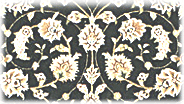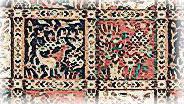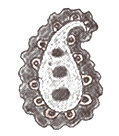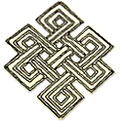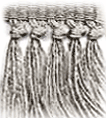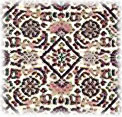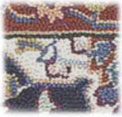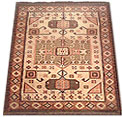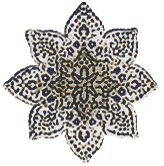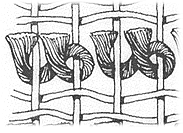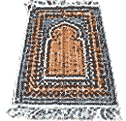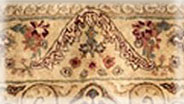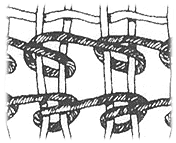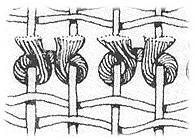RUG GUIDE
Rug Introduction  The Illustrated Rug
The Illustrated Rug 
From Sheep To Rug 
Rug & Knot Types 
Rug Loom Types 
Basic Rug Care 
Stain Removal Guide 
Decorating Ideas 
Purchasing Guide 
Names & Places 
Rug History Chart 
Glossary of Terms 
Presented by NEJAD RUGS:
|
|
All-over design - A term used to describe a rug without a central medallion but with a design repeated throughout the field. Antique Finish/Wash - a chemical soaking process designed to to simulate aging by modifying color saturation and intensity Art Silk - Also called artificial silk - refers to the use of processed (mercerized) cotton as a substitute for silk. Aubusson (Aubuson) - These fine flat-woven carpets, featuring formidable sized rugs in pastel colors with floral medallions, were produced in France from the 15th - 19th centuries. Axminster Rug (Loom) - First produced in the 1880's, machine-made rugs were mechanically woven to a flexible cotton frame and having up to 70 colors of wool. Border Rug - A rug featuring a design on the outer rim, or border, of the rug, surrounding the field.
Broadloom - Carpet(s) produced in widths of at least 6'. Brocade - Weft float weave used to add design and embellishment. Often seen on the kilim bands at the ends of oriental rugs Cartouche - Oval-shaped ornament incorporated into the rug design containing a signature, date, or inscription Carved Pile/(Map) - Design or pattern cut or "embossed" into the pile of a rug - common in Chinese and Tibetan carpets. Chain Stitch - A crochet stitch used in rug construction that consists ol successive loops to lock the final weft in place at the end of a rug. Dhurrie - A flatwoven rug from India, usually made of cotton or wool.
Flat-Weave - term describing any rug without (wool) pile: including Soumaks, Kilim, Verneh, Sozani, and Dhurie. (Aubuson carpets, though flat, are excluded from this category due to factors such as their complexity) Field - The part of a rug's design surrounded by the border. The field may be blank or contain medallions or an over-all pattern. Gabeh - A long-piled rug style with a simple colorful design - originally used as mattresses - that have attained recent popularity. Gul - A medallion either octagonal or angular in shape used in Turkoman designs It is often repeated to form an all-over pattern in the field. Handmade Rug - A rug that is either entirely handknotted (or handtufted) and usually made of wool, and which may also include the addition of silk. Heriz - City on Iran-Azerbaijan border and name for the geometric medallion rugs popularized in the early 20th century. This design remains extremely popular in Europe and the U.S.A.
Kashmir - Upscale carpets made of either silk or mercerized cotton from the Islamic region of India - woven with a Persian knot. Kilim - A flat-woven (pileless) carpet, often reversible, in which a design pattern is formed by colored weft strings being wrapped around the warp. Knap - the brush-like surface of the rug, created when the knot loops are cut. Knot - the basic technique used to create an Oriental carpet: Two types of knots are used:
Knot count - In the process of making a hand knotted rug, each strand of yarn is knotted to the foundation: The higher the number of knots per square inch - the higher the quality of the rug. Knotted - Process by which a rug is hand woven with wool (or silk) and secured to a cotton foundation by knotting - thus producing a rug of superior quality. Such a rug could be classified as "knotted", "hand-knotted", "hand-woven" or "hand-made"(handmade). Factors that may affect or increase value/cost are the density of the pile (knots per square inch) as well as the intricacy of the design motif. Line Count - The number of horizontal knots per linear foot. (As with knot count, the higher the number, usually the higher the quality of the rug).
Mori - The weaving technique of certain Pakistani and Indian rugs. Natural rug - Often refers to an earth-toned rug whose texture - sisal, jute or wool - is the identifying feature. Oriental - referring to an Oriental rug or carpet:
Overcasting - the technique of rounding the wool edges of the vertical sides of a rug to prevent fraying Patina - Term referring to the "mellowed" surface appearance of a rug - due to age or use
Pile - The nap of the rug or the tufts remaining after the knotted yarns are dipped. Pile weave - The structure of knotted carpets and rugs forming a pile or nap: Wool, silk, (sometimes cotton) is knotted around the warp in a variety of techniques. Plain Weave - The simplest interfacing of warp and weft. Runner - A long, narrow rug, usually under 3 feet wide, primarily used in hallways and on staircases. Sarouk - Woven carpets produced in Sarouk region of Iran renowned for their beauty. Frequently seen in lobbies of fine American hotels and estates in post-WW2 era. Selvage - the area between the edge of a rug and the fringe
Tapestry - Generic term referring to a flat-woven wall hanging characterized by rich pastoral design settings. Tapestry Weave - Any variety of weaves where the pattern is created by ground wefts that do not run from end to end. Tea Wash - A procedure used to soften the colors in order to give a rug the appearance of age. Tribal rug - A term used interchangeably with gabbeh to describe a primitive-looking or Southwestern rug. Tufted - A process in which tufts of wool are punched through a base fabric. The underside of the base is then painted with Latex glue and covered with a backing material.
Warp - Comprising the structure parallel wrap yarns run the length of the rug and are interlaced with wefts. Weft - The yarns woven horizontally through the warps. Weft-Faced - A rug where the weft yarns are more closely spaced than the warps. Yarn Ply - Number of single strands of yarn that are twisted together to form a plied yarn.
|



